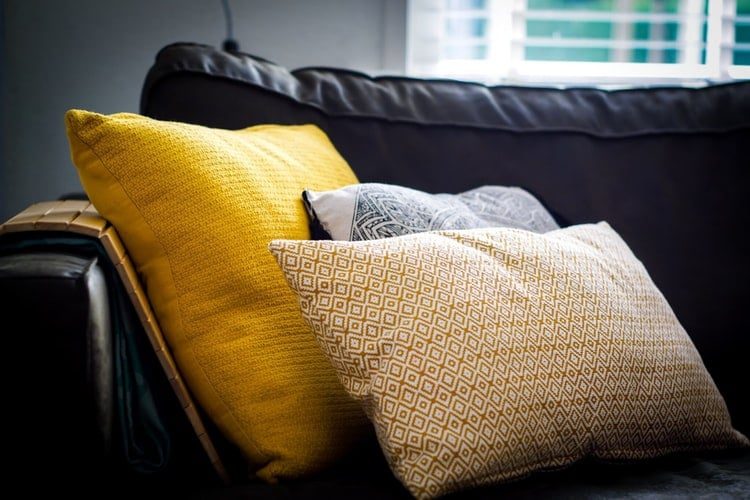If you want a clean finish to your cushion and at the same time highlight its outlines, then check out how to sew an invisible zipper in a pillow with cording.
Cording is characterized by a decorative fabric wrapped around a thin rope to emphasize the pillow shape. It also strengthens seams and protects the cushion’s cut edges.

Your Guide on How To Sew An Invisible Zipper In A Pillow With Cording
In this project, you will be installing an invisible zipper on a pillow with cording. The materials that will be used are your sewing machine, pencil or chalk, cutter, pins, iron, two fabrics and a pillow form of the same size, a cord and extra cloth for it, and a zipper.
Step 1: Prepare the fabric strips
The fabric strips here refer to the cloth that wraps around the piping cord, which comes in different types and thicknesses. The width is equal to the seam allowance and the cord’s width, multiplied by two, while the length depends on the pillow’s perimeter.
Step 2: Sew the cut fabric around the piping cord
Lay the welting cord in the middle of the fabric strips and fold it lengthwise. Afterward, using your sewing machine with a zipper foot, sew as close to the cording as possible, but make sure that it is not too tight at the same time.
Step 3: Attach the cording to the front cover
Get the front fabric for the pillow and sew the piping on all sides. Make sure to allocate extra inches at the beginning of the cord for allowance. When you are only a few inches away from the finish point, cut the remaining piping, and connect the ends.
Step 4: Hide the teeth of the zipper
If you already have an invisible zipper with fine teeth, then you can skip this part. Otherwise, make sure that they are open and face side down. Put your iron in the lightest setting, push the rolled-up teeth down, and flatten the opposing sides.
Step 5: Sew the invisible zipper to the covers
Once again, the zipper must be open and face side down for this step. Get the right portion and pin it next to the cording for as close as you can. Sew it on one side of the pillow until you cover the whole length. Do the same thing for the left counterpart.
Step 7: Close up all sides of the pillow
Align the fabrics with the front and back covers facing the wrong side up, then pin them together. Sew close to the cording for all sides, excluding the opening. Before turning the pillowcase inside out, cut the corners and the remaining tail of the zipper.
Additional Must-Have Tips
While following or reading through the tutorial, there are parts that you are recommended to follow. These are essential tips that can make a difference in the finishing product. Here are some of them.
When cutting the fabric for the cord, cut diagonally
This bit is not compulsory, as straight cut saves fabric, and elasticity doesn’t matter much when the pillow doesn’t have precise curves. Otherwise, cut diagonally or on the bias so that the fabric stretches well on the corners.
Backstitch the beginning and end
This is a tip that can come in handy in many sewing projects. Backstitching helps in strengthening seams and locking the stitches that you have made into place. Therefore, if you do not want the ends of a seam to fall apart easily, perform this technique.
The Benefits of Using a High-Quality Pillow
If you value a good night’s sleep, then getting yourself some high-quality pillows is a must. Here are some of the benefits of using high-quality pillows:
Pillows keep your spine aligned
Our necks are uniquely designed to curve forward to support the weight of our heads. To avoid spinal issues, it’s important to maintain this curve even when sleeping or resting.
If the pillow is too high when you’re sleeping sideways or on your back, your neck and shoulders are positioned abnormally, causing muscle strain on your shoulders and neck area. This position can also narrow your air pipe, which can result in obstructed breathing. Your neck muscles could also be strained if the height of the pillows is too low.
The perfect height of the pillow depends on your body’s measurements and your preference. But generally, your pillow should be around the height of 10 to 15 cm to properly support your head, neck, and shoulders.
Pillows make you comfortable
What makes a good pillow? It all boils down to personal preference. A good pillow should help you relax after a long day and feel rested when you wake up in the morning. The pillowcase plays a role in comfort as well. Some people prefer silk pillowcases, while others prefer cotton or flannel.
Final Thoughts on How to Sew an Invisible Zipper in a Pillow
Knowing how to sew an invisible zipper in a pillow with cording will surely come in handy when making welted cushions. After all, invisible zippers give off a clean and flat finish that you would want for any of your DIY pillow-making projects.
